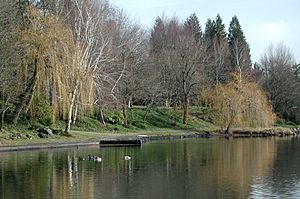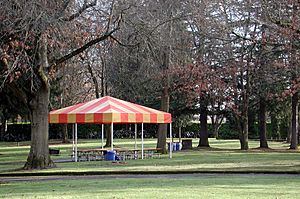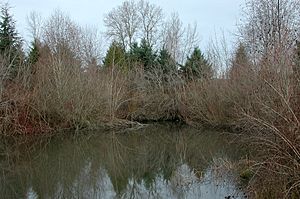Blue Lake Regional Park facts for kids
Quick facts for kids Blue Lake Regional Park |
|
|---|---|

Shoreline in winter
|
|
| Type | Urban park |
| Location | Fairview, Multnomah County, Oregon |
| Area | 101 acres (41 ha) |
| Operated by | Metro regional government |
| Open | 8 a.m. to legal sunset. Entrance fee except for pedestrians and bicyclists. Closed on Christmas and New Year's Day. |
Blue Lake Regional Park is a cool public park located in Fairview, a town in the state of Oregon, United States. This park is huge, covering about 101-acre (41 ha) of land. It's right near the Columbia River in Multnomah County.
The park is a great spot for outdoor fun. You can find lots of picnic areas, both covered and open. There are also big fields for sports like softball. If you like running, there's even a cross country course.
Blue Lake Regional Park is also perfect for lake activities. You can go swimming, boating, and fishing here. The park has forests, three small ponds, and a wetland. Many birds and other wildlife visit the park, especially during migration. You'll find paved paths for walking or biking, and the park is close to the 40-Mile Loop trail.
The park's plants include tall cottonwood trees and willows. You'll also see wetland plants like cattails.
The lake itself is about 61-acre (25 ha) big. It's a special lake because it doesn't have natural rivers flowing into or out of it. Water mostly comes from rain, surface runoff, and water seeping up from the ground. Sometimes, too many water plants or algae can grow in the lake. Park staff work to control these plants and add fresh water to keep the lake healthy.
Contents
Where is Blue Lake Park?
Metro, the local government for the Portland area in Oregon, takes care of Blue Lake Regional Park.
The park is in Fairview, close to the south side of the Columbia River. It's about 3 miles (4.8 km) northwest of Troutdale. It's also about 11 miles (18 km) east of downtown Portland. A road called Marine Drive and the 40-Mile Loop trail run north of the park, between it and the river.
A Look at Park History
A famous explorer named William Clark visited this area in April 1806. He was on his way back from the Lewis and Clark Expedition. He met people from the Nichaqwli (or Nechacokee) tribe who lived near the Willamette River.
Blue Lake was a private park for many years, from the 1920s until 1960. Then, Multnomah County bought it. Later, in 1994, Metro started managing the county's parks. Metro officially owned the parks by 1996. There used to be a dance hall at the park, but it was removed after Multnomah County took over.
Fun Things to Do and See
Blue Lake Regional Park has many great features for visitors. You'll find public restrooms and most areas are easy to access for wheelchairs. There are trails for walking and biking, and plenty of parking. You can also use sheltered picnic areas and tables. The park has signs that teach you about the area, and there are places to buy snacks.
You can do many activities at the park, including:
- Hiking
- Biking
- Cross country running
- Swimming
- Boating
- Fishing
- Watching wildlife
- Playing volleyball
- Playing basketball
- Disc golf
- Archery
- Softball
The park also has a cool water-spray playground. It's about 3,500 square feet (330 m2) big and uses treated water from city wells. This water is recycled right there at the park.
At the west end of the lake, you'll see sculptures. These artworks remember the old Chinook villages that used to be along the Columbia River. If you need a bigger space, Metro offers a large building called The Lake House. It's about 2,080-square-foot (193 m2) and can be rented for parties, meetings, or weddings. The Oregon Department of Fish and Wildlife adds trout to Blue Lake every year, so there are always fish to catch!
Wildlife and Plants
Near the ponds north and west of the lake, you'll find wetland plants like cattails and rushes. These plants are home to marsh birds such as red-winged blackbirds. You'll often see swallows in the summer. Many American goldfinches and other birds that travel long distances visit the park too.
The park has many different trees, including cottonwoods, alders, dogwoods, willows, and conifers. There are also many shrubs like elderberries, spiraea, and Oregon-grape. You might even spot some animals like muskrats, voles, raccoons, and sometimes a coyote.
How the Lake Works
The lake covers about 61 acres (25 ha) of the park. It sits in its own special area that collects water, about 128 acres (52 ha) in size. This area is surrounded by a raised bank along the river to the north. Roads and a sandstone ridge also help define its edges.
The lake is about 14 feet (4.3 m) above sea level. It's about 0.9 miles (1.4 km) long from east to west and 0.12 miles (0.19 km) wide from north to south. The deepest part of the lake is about 24 feet (7.3 m), but half of it is 10 feet (3.0 m) deep or less. The shoreline around the lake is about 2 miles (3.2 km) long.
Since no rivers flow into the lake, it gets its water from rain, water running off the land, and water seeping from underground. Sometimes, during dry periods, water from city wells is pumped into the lake. This helps keep the water level from dropping too much. There are three smaller ponds north of the lake that are connected to it. Water only leaves the lake when park workers open a special gate. This water then flows into Salmon Creek and eventually into the Columbia River.
Because the lake is mostly closed off, it can sometimes have water quality issues. Plants like Eurasian watermilfoil and curlyleaf pondweed can grow too much. This can make it harder to swim, fish, or boat. The Oregon Department of Environmental Quality has listed the lake as having water quality problems because of too many weeds and algae. Park staff are always working to control these plants and keep the lake healthy for everyone to enjoy.



